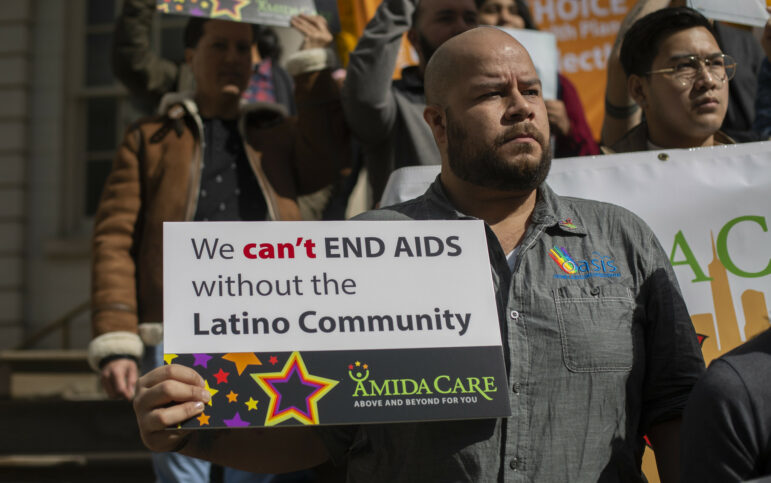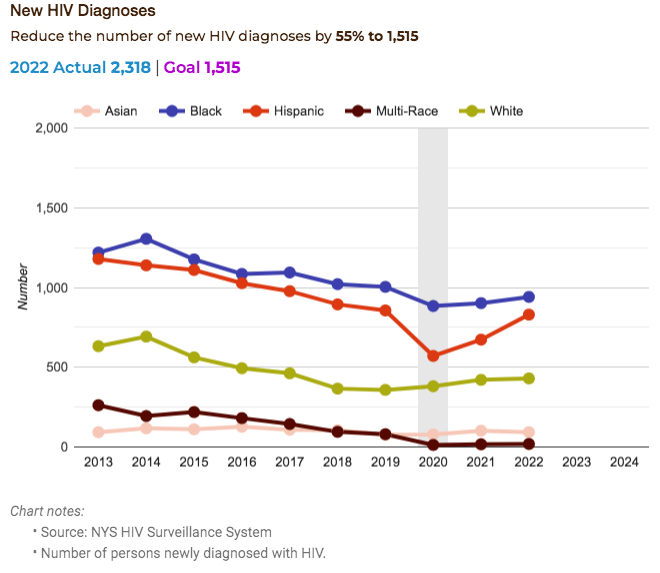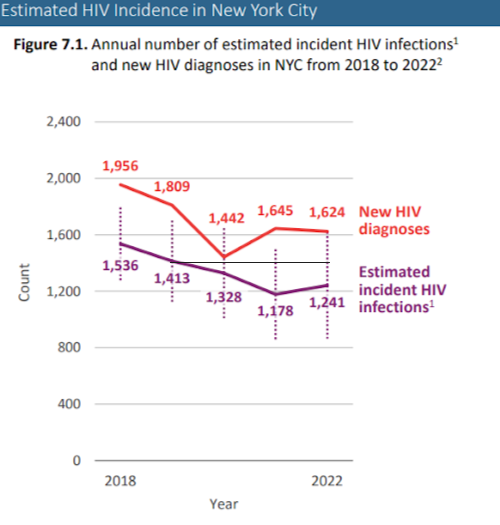While experts cautioned that the low numbers in 2020 should be taken with a grain of salt—likely an undercount due to the pandemic, and at odds with a longer term decline in new cases—the upward trend in 2021 and 2022 has caused alarm among HIV researchers and advocates.

NYC Council/John McCarten
A 2019 press conference outside of City Hall, regarding AIDS awareness in the Latino community.Lea la versión en español aquí.
According to the latest report from the U.S. Centers for Disease Control and Prevention (CDC), the number of HIV diagnoses increased nationwide in 2022—the most recent year for which data is available—especially among groups such as transgender women and Latinos who are gay, bisexual, and men who have sex with men (MSM).
Locally, New York continues to show an overall downward trend in new HIV diagnoses, but among some racial and ethnic groups, that decline stalled in 2020, when the COVID-19 pandemic hit the city.
While both experts and officials cautioned that the low numbers during 2020 should be taken with a grain of salt—a likely undercount due to the pandemic—the upward trend in 2021 and 2022, both in the city and nationally, has caused alarm among HIV researchers and advocates.
According to the Ending the Epidemic (ETE) Dashboard System, the increase in statewide HIV diagnoses among Latinos—from 571 cases in 2020, to 673 in 2021, and 830 in 2022—is steeper than among other racial and ethnic groups, which also saw recent increases.

Ending the Epidemic Dashboard
New HIV diagnoses by year and by racial and ethnic group across New York State.“You can see the trend in New York and New York City is not going in the right direction,” said Denis Nash, executive director of the CUNY Institute for Implementation Science in Population Health (ISPH), which designed and developed the ETE Dashboard System.
In 2022, 1,624 people were newly diagnosed with HIV in New York City, with Latino and Black New Yorkers accounting for 83 percent of new diagnoses.
The New York City Department of Health and Mental Hygiene (DOHMH) acknowledged that despite an overall decrease from 2018 to 2022 among Latinos, they continue to be disproportionately represented among all people newly diagnosed with HIV, experiencing the second-highest number after Black New Yorkers.

NYC Dept of Health & Mental Hygiene
“Our commitment to ending the epidemic is unwavering and we know that to reach that goal all roads run through equity,” DOHMH Spokesperson Patrick Gallahue said in a statement sent via email. “We can only succeed when we focus our energies where the impact has been felt the greatest. This principle is reflected in the work we do every day.”
Both the city and state health departments and experts contacted by City Limits pointed to barriers that continue to affect Latinos, including HIV-related stigma, language barriers, limited access to health services, racism, xenophobia, socioeconomic factors, and inadequate sexual health education.
“Addressing these multifaceted challenges demands a comprehensive approach that includes targeted education, culturally competent healthcare services, and efforts to reduce stigma,” said Brandy Andrews, HIV & sexual health services manager at The Center.
“We need to promote inclusive HIV prevention strategies that focus on the needs of marginalized communities, making sure everyone can access timely and effective healthcare without fear or discrimination,” Andrews added.
In addition to these factors, the pandemic itself hit the entire health system hard and continues to have ramifications. The New York State Department of Health (NYSDOH) said that pandemic-related impacts such as behavior changes, facility closures, and staffing capacity continue to impact populations already disproportionately affected by HIV.
“Addressing persistent health inequities, the social determinants of health and racial disparities remains the center of our focus as we move forward with ending the epidemic efforts in New York State,” a NYSDOH spokesperson said. “The Department remains committed to ensuring that all New Yorkers have access to comprehensive and affirming sexual health and preventive services.”
In 2022, Black New Yorkers represented 22 percent of the city’s population but 43 percent of all newly diagnosed HIV cases, while Latinos made up 29 percent of all residents but accounted for 40 percent of new diagnoses.
Both the state and the city health departments said they operate programs designed to reach communities of color. The New York State Department of Health’s AIDS Institute (NYSDOH AI) provides funding to develop and enhance comprehensive HIV and other Sexually Transmitted Infections (STI) programs, with a focus on communities of color (Black, Latino, Native American/Indigenous people, and Asian populations).
NYSDOH said that it also funds several strategies to prevent HIV and sexually transmitted infections, such as connecting people to testing and to preventative measures like Pre-exposure Prophylaxis (PrEP) and Post Exposure Prophylaxis (PEP).
When asked, NYSDOH did not detail how much it spends on prevention efforts, saying it is provided concurrently with a full array of HIV, STI and sexual health services. At the national level, only 4 percent of nearly $30 billion in federal money that went toward HIV services in 2022 went to prevention, the Associated Press reported in June.
The city’s DOHMH also did not specify how much money it spends exclusively on HIV prevention, although it described recently-developed initiatives that include prevention. For example, in 2021 it developed the Ending the HIV Epidemic Plan that identified priority populations—such as Black and Latino men who have sex with men (MSM), Black and Latina women, and Black and Latino transgender men and women.
In fiscal year 2024, which ended in June, the DOHMH awarded more than $11 million to organizations across the city that are part of the PlaySure Network 2.0, which delivers HIV and sexual health services in both medical and non-medical environments.
In both the state and the city, young New Yorkers between 20 and 39 saw the highest number of new diagnoses in 2022. People in this age group accounted for 1,514 of the 2,318 new HIV diagnoses in the state. In the city, where 20- to 39-year-olds make up only 30 percent of the population, they account for two-thirds of new HIV diagnoses.
And just as nationally, where the number of new HIV infections is on the rise among young gay Latinos, Latinos between the ages of 20 and 39 had the highest number of new HIV cases in New York City in 2022 compared to any other group, accounting for 29 percent of all cases. And nearly 27 percent came from the same age group of Black residents.
“The state and the city are investing and are well positioned nationally,” said Daniel Castellanos, vice president of research and innovation for the nonprofit Latino Commission on AIDS.“What we see is a need for much more focused, Latino-focused targeted and local efforts.”
The DOHMH insisted that data for 2020 to 2022 reflect the impact of COVID-19 and should be interpreted accordingly, and the increases likely include delayed HIV testing during 2020.
According to city data, about a quarter of new HIV diagnoses were detected among people who were born outside of the U.S. in 2022. Moreover, foreign-born Latinos experienced the highest number of new HIV diagnoses, representing 59 percent among people born outside the U.S. that same year.
Johnny Guaylupo, assistant program director for youth prevention services at Housing Works, acknowledged these efforts, but said more is needed, “especially with the influx of migrants that we have seen [since 2022].”
In a similar trend, those between 20 to 39 years old represented 62 percent of new diagnoses among foreign-born New Yorkers in 2022.
One of the biggest fears shared by both Castellanos and Gustavo Morales, director of Oasis Community Pride Center, is that the data currently available shows what happened two years ago, meaning officials are reacting to old patterns and don’t know how the trends are behaving today.
This year, the DOHMH launched an updated “Be HIV Sure” campaign promoting HIV testing, prevention, and care services through a new mobile texting number (55676), available in both English and Spanish, regardless of immigration status.
And in June, the Health Department also reissued its “Summer of Sexual Health” campaign, initially introduced in July 2023, encouraging New Yorkers to access necessary sexual health services and directing them to the NYC Sexual Health web page for information on low- to no-cost care options, also available in English and Spanish.
With the unveiling of the city’s final budget in late June, the Adams administration reversed cuts to HIV/AIDS programs announced in May, which sparked backlash from LGBTQ+ nonprofits.
DOHMH said that the information it collects through HIV Surveillance Data helps it to identify, design, and implement programs, a process that also includes feedback from providers and community partners. The Department also funds the Latino Commission on AIDS (LCOA) to partner with dozens of faith-based organizations to deliver HIV outreach services in predominantly Spanish-speaking, Latino areas.
“To effectively engage Latino youth, it’s crucial to meet them where they already gather,” Andrews said. “This involves attending Latino events, setting up booths in community spaces like neighborhood centers and parks, and leveraging social media platforms they use. By physically and digitally positioning ourselves where they are, we can initiate conversations about their interests and needs.”
To reach the reporter behind this story, contact Daniel@citylimits.flywheelstaging.com. To reach the editor, contact Jeanmarie@citylimits.flywheelstaging.com
Want to republish this story? Find City Limits’ reprint policy here.








